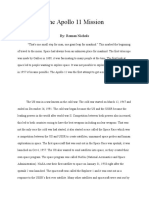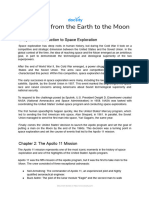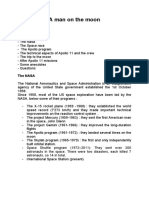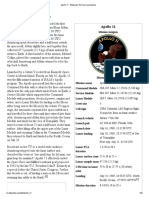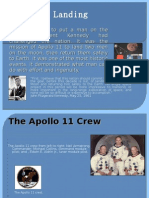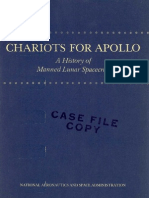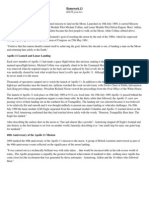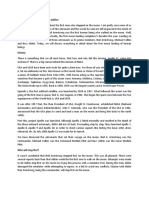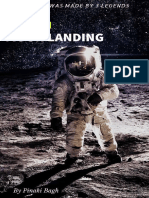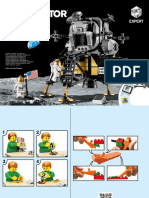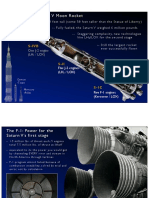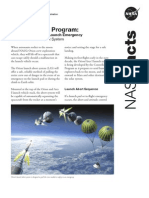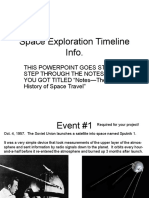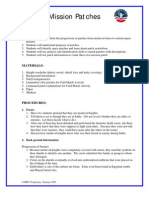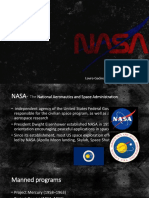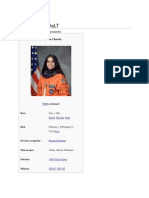Annotated Bibliography
Secondary:
"About the Spacecraft." National Air and Space Museum. Smithsonian, n.d. Web. 8 Oct. 2016.
The spaceship needed to provide everything the astronauts needed for their journey which
included protection, flight and work equipment, air, food, clothing, the space-equivalent
of bathrooms, and more. The Apollo 11 spacecraft had 3 parts, the Command Module
Columbia, a Service Module, and the Lunar Module Eagle. The Command Module
Columbia carried the astronauts to the moon and back. The Service Module contained
oxygen, water, and electric power for the command module. It also had a rocket
propulsion system, a rocket that puts the spacecraft into lunar orbit and later into Earths
orbit. The Lunar Module was used for a descent on the lunar surface and a base while the
astronauts were on the Moon.
"Apollo 11 Mission." Apollo 11 Mission. N.p., n.d. Web. 03 Dec. 2016.
When the crew was on the moon, they deployed several experiments. They either radioed
the results to Earth or returned to Earth for laboratory analysis. The crew had returned
with the first geologic samples of the Moon. The samples had no water and no evidence
to living organisms in the Moons history.
Chaikin, Andrew, Victoria Kohl, and Alan Bean. Mission Control, This Is Apollo: The Story of
the First Voyages to the Moon. New York: Viking, 2009. Print.
There werent just three people flying the Apollo mission, there were dozens. The
astronauts relied on their team of experts to solve any problems that came up. The
controllers are in a room called the Mission Operations Control Room, or MOCR. Each
controller had a console with a TV screen that shows information. In one of the last
�simulations before a mission, they faced a problem and Bales, a controller in charge of
monitoring the lunar modules computer, solved it and it wasnt the first time a flight
instructor saved a mission.
Dunbar, Brian. "One Giant Leap For Mankind." NASA. NASA, 14 July 2014. Web. 8 Oct. 2016.
On July 16, 1969, Apollo 11 astronauts Neil Armstrong, Buzz Aldrin, and Michael
Collins are on the Saturn V at the Launch Complex 39a at the Kennedy Space Station. At
9:32 a.m. the engines fire up and 12 minutes later, they are out of Earths orbit. With
more than a half a billion people watching on television, Armstrong climbs down the
ladder and says, Thats one step for a man, one giant leap for mankind. Aldrin joins
him shortly to collect samples and take photographs. They leave behind an American flag
to remember the fallen Apollo 1 crew.
"First Explorers on the Moon." The Flight of Apollo 11 National Geographic Magazine. N.p.,
n.d. Web. 03 Dec. 2016.
Armstrong and Buzz Aldrin were descending onto the Moon. The Eagle was breaking its
fall as it should be until the problem was clear, they had only 5 percent of the Eagles
descent fuel left. They had only 94 seconds left. At 60 seconds, the countdown began. It
would be success or failure and it would be very hard to fail. If they couldnt get to the
Moon in time they would have to go back to the Columbia. At 30 seconds the mission
director started pleading silently, Get it down, Niel! Get it down!. Within 20 seconds
came the magic words: Contact light! The space probes had touched the surface.
Floca, Brian. Moonshot: The Flight of Apollo 11. New York: Atheneum for Young Readers,
2009. Print.
�The Saturn V launch vehicle has three stages. The first stage of the vehicle lifts Apollo 11
to 40 miles and is separated at 2 minutes and 42 seconds, it is also on the bottom. The
second stage lifts Apollo 11 to 117 miles and is separated at 9 and 12 seconds, it is in the
middle. The third stage inserts Apollo 11 into Earth's orbit and reignites at 2 hours and 44
minutes for translunar injection, pushing Apollo 11 out of orbit and toward the Moon.
Green, Carl R. Apollo 11 Rockets to First Moon Landing. Berkeley Heights, NJ:
MyReportLinks.com, 2004. Print.
The Cold War began a peaceful rivalry called the space race. The Soviets were the first to
launch an Earth satellite in 1957. The American space program was forced to catch up
and suffered a series of rocket mishaps. The moon was a big prize, once an astronaut put
their flag on the moon, nothing else would matter said Kennedys advisors. He said
winning the space race is vital if we want to win the battle between freedom and tyranny.
Kennedy called on the nation to commit itself to achieve the goal of landing a man on the
Moon and returning him safely on Earth.
Green, Carl R. Walking on the Moon: The Amazing Apollo 11 Mission. Berkeley Heights, NJ:
Enslow, 2013. Print.
NASA picked astronauts that would fly the aircraft. Most were former test pilots wanting
to fly the most complex vehicle ever built. They spent much of their time in simulated
space flights. The training covered every part of a moon flight. They were also dropped
off in a desert to practice surviving skills, learning to work in space suits also turned into
an endurance test.
History.com Staff. "Apollo 11." History.com. A&E Television Networks, 2010. Web. 03 Dec.
2016.
�After they had traveled 240,000 miles, they had entered lunar orbit. The next day, the
lunar module Eagle, manned by Armstrong separated from the Command module where
Collins was. 2 hours later, the Eagle began its descent. At 4:17 p.m. the craft finally
reached the southwestern edge of the Sea of Tranquility.
McKie, Robin. "How Michael Collins Became the Forgotten Astronaut of Apollo 11." The
Observer. Guardian News and Media, 18 July 2009. Web. 03 Dec. 2016.
As his spacecraft, Columbia swept over the lunar surface, Michael Collins waited for the
call from Neil Armstrong and Buzz Aldrin to say their lander craft had successfully
blasted off from the Moon. It was Collins deepest fear to be the only survivor of the
Apollo 11 disaster and he had to return back to the United States as a marked man. All
of the crew had doubts and they all knew that there was a chance of the mission to end
disastrous. Most people still know the names of the two men on the moon and know the
words from Armstrong but they rarely recall Michael Collins despite his huge role.
�Primary:
"Apollo 11 Flight Plan | National Archives." National Archives and Records Administration.
National Archives and Records Administration, n.d. Web. 03 Dec. 2016.
This website shows me that the Apollo 11 trip wasnt very easy. It seemed like the crew
had just got to the Moon when they did but they had really planned when they were going
to touchdown. They had successfully landed on the moon as scheduled. This plan shows
that these important events would have been so successful if you dont have a plan.
"Apollo 11 Images." National Air and Space Museum |. N.p., n.d. Web. 07 Nov. 2016.
I learned that the lunar mission flight path has much more to it than I thought there
would. For example, there is a label that tells where one of the Saturn V parts disconnect.
I also learned that president Nixon visited the Apollo 11 crew in Quarantine. The
astronauts also got a parade when they arrived back from the Moon.
"Buzz Aldrin Interview." Interview with Buzz Aldrin. N.p., n.d. Web. 07 Nov. 2016.
The crew was closely bonded because of their shared experiences with each other. The
surface of the Moon is not like Earths, it lacks any evidence of life. A pen had also saved
Buzzs life when Buzz and Neil tried to lift off from the moon. The pen was used to
engage the arms circuit breaker which had broken off after the moonwalk.
"In Event of a Moon Disaster." Letters of Note. N.p., n.d. Web. 03 Dec. 2016.
This letter was sent to President Nixon in event of Apollo 11 failing. This tells me that
they were ready for failure. From all of the of mishaps that had happened, the chance of
failure wasnt very slim.
"Neil Armstrong Talks About The First Moon Walk." NPR. NPR, n.d. Web. 03 Dec. 2016.
�I learned that they tried to reproduce the environment of the Moon to test out the
astronauts equipment. NASA officials also limited their surface working time to 2 and
hours to assure that they would not expire of hypothermia. Neil Armstrong also
questioned why Americans dont go to the Moon anymore because we have so much we
have yet to explore.
